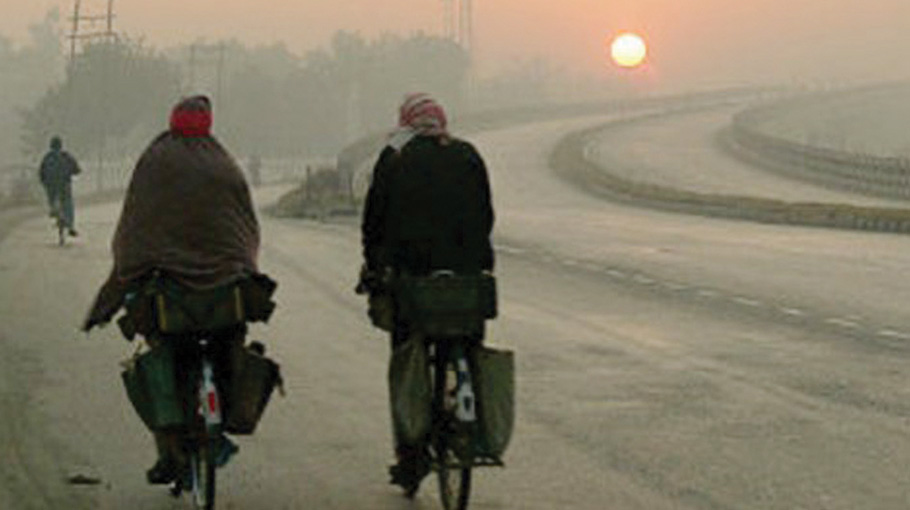Country shivers
Schools closed in 3 northern dists

In the wake of the ongoing extreme cold weather, especially experienced in the northern regions for the past few days, the government has decided to suspend classes in schools in three districts - Rajshahi, Joypurhat and Kurigram.
In Rajshahi, the lowest recorded temperature in the northern district was 9.5 degrees Celsius on Saturday (January 21). The local meteorological department on Friday predicted that the district would experience less than 10 degrees Celsius temperature for two days (January 21 and 22).
Following the forecast, education officers of the district held a meeting and decided to keep all the primary and secondary schools closed for two days, starting from Saturday.
The regional office of the Directorate of Secondary and Higher Education (DSHE) has ordered the temporary closure in a notice signed by Dr Sharmin Ferdous Chowdhury, the acting deputy director of the DSHE (Rajshahi).
“In light of the hazardous weather conditions, the directorate has ordered to close schools. This directive is issued in compliance with those guidelines. Classes will resume as usual on Tuesday (23 January) once the weather improves,” she said.
Meanwhile, due to the unfavourable weather conditions, all primary schools in the district will also remain closed. Saidul Islam, the primary education officer of the district, said that academic activity at the primary schools will remain closed only on Sundays but the offices will remain open as usual. “Observing Sunday’s weather, the next course of action will be decided,” he said.
A mild cold wave is sweeping through Rajshahi, causing significant disruptions to daily life. The combination of dense fog and chilly winds has led to challenging conditions for the locals there.
Rajib Khan, observer at Rajshahi Meteorological Observatory, said that the minimum temperature in Rajshahi dropped to 9.6 degrees Celsius on January 13. The second lowest temperature of the season was recorded at 9.8 degrees Celsius at 7:30 am on Friday.
In Joypurhat, the Deputy Commissioner (DC) of the district Salehin Tanvir Gazi said that in light of the severe cold conditions, they have decided to shut all primary and secondary schools in the district for two days. The decision follows a report from the nearby Naogaon meteorological office, which recorded temperatures in the Joypurhat district dipping below 10 degrees Celsius.
The cold snap has dramatically altered daily life in the district. On Sunday noon, the sun remained hidden, compelling vehicles to ply the streets with headlights on, a rare sight for the region.
In Kurigram, the district administration has extended the closure of 1,848 educational institutions, including primary, and secondary schools and madrasas, until temperatures rise above 10 degrees Celsius.
Kurigram DC Mohammad Saidul Arif advised students to stay indoors and continue their studies, highlighting the seriousness of the situation.
This shutdown in the three northern districts comes after a previous directive from the Directorate of Secondary and Higher Education (DSHE) on January 16. The DSHE granted regional authorities the power to close schools if temperatures fall below 10 degrees Celsius.
As the northern parts of Bangladesh continue to grapple with this harsh cold wave, the closure of schools underscores the impact of extreme weather on education and daily life.
However, this weather pattern is expected to persist, bringing lower temperatures and impacting daily life.
The Bangladesh Meteorological Department (BMD) in its regular weather bulletin on Sunday said that the mild cold wave was currently affecting several districts across the Dhaka, Rangpur, and Rajshahi divisions.
According to the BMD bulletin, the districts experiencing this mild cold wave include Kishoreganj, Rajshahi, Pabna, Naogaon, Panchagarh, and Kurigram.
The bulletin says that the lowest temperature recorded at 9.5 degrees Celsius in Rajshahi, Pabna’s Ishwardi, and Naogan’s Badalgachi. However, the highest temperature of 28 degrees Celsius was recorded in Chattogram’s Sitakunda.
The BMD classifies a mild cold wave as temperatures ranging from 8 to 10 degrees Celsius. A moderate cold wave is categorized by temperatures between 6 to 8 degrees Celsius, while a severe cold wave is indicated by temperatures falling below 6 degrees Celsius.
Furthermore, the weather report predicts moderate to thick fog coverage across the country from midnight to morning, potentially lingering until noon in some areas. The overall weather is expected to remain mainly dry, with temporary partly cloudy skies.
There might be a slight decrease in night temperatures over the north-northeastern part of Bangladesh, while a minor increase is forecasted for other regions of the country. Daytime temperatures are anticipated to stay nearly unchanged nationwide.
Working people, particularly in the northern regions, are facing greater difficulties from the cold. People suffering from cold-related diseases are flocking to hospitals. Colds, coughs, pneumonia, and breathing difficulties have been recorded. Many are also suffering from cold diarrhoea.
Hospitals even in Dhaka city are witnessing a daily surge in patients suffering from cold-related illnesses.
Day labourers, children and elderly people are worst hit by the shivering cold. Meanwhile, farmers in many districts are worried as bone-chilling cold is affecting their boro seedbeds.
As the winter has intensified, the sales of warm clothes rose at makeshift roadside shops in Dhaka city and other parts of the country. Shops on rickshaw-vans selling warm clothes draw huge crowds at night, and the sale of clothes and blankets has increased comparatively in the past few days.





